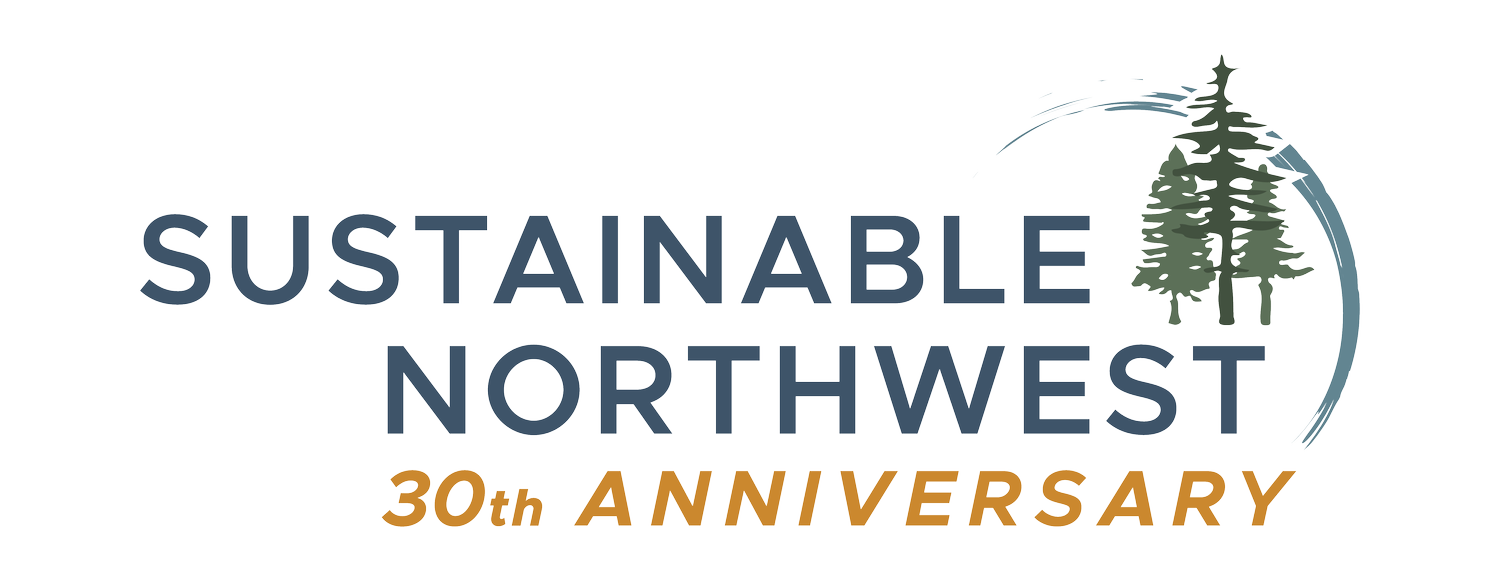Restoration Wood & Mill Tour in John Day Oregon
Sustainable Northwest recently convened 15 architects, designers, construction firm representatives, and others in the green building space for a tour in John Day, OR.
The trip included visits to Woodgrain’s sawmill in Pilot Rock, Malheur Lumber in John Day, and restoration projects on the Middle Fork John Day and Malheur National Forest.
Sustainable Northwest’s Green Markets Program held a tour on June 16th & 17th in Eastern Oregon, showcasing the important connection between public land forest restoration and mills in rural parts of Oregon. In partnership with Blue Mountain Forest Partners, Malheur Lumber, and Woodgrain Pilot Rock, we brought over 15 design, construction, and architectural professionals from across Oregon and Washington out to John Day.
Our trip began at the Woodgrain sawmill in Pilot Rock, where we toured the mill and learned about the various products that Woodgrain supplies to market. While this specific mill is primarily a pine mill, Woodgrain as a whole is vertically integrated, with most of its pine products going into moldings, architectural millwork, and windows. The opportunity to trace these products back to their forest of origin is on the table and something Sustainable Northwest is eager to put into practice.
We hit the ground running on Friday, starting bright and early with a tour at Malheur Lumber, based in John Day. Malheur was able to show us their log deck, processing, sorting, and give all the people in the room an overview of the products they offer. Most importantly, people on the tour have walked away knowing how to connect with Malheur on sourcing for their next project.
The primary goal of this tour was to link the restoration that happens on the nearby Malheur National Forest with the wood products created; when project teams purchase wood from mills like Malheur and Woodgrain, they can support rural parts of Oregon and forests that are more resilient to drought, disease, and fire.
On this tour we had representatives from the City of Portland, ZGF Architects, LEVER Architects, Walsh Construction, along with people in academia, conservation, and wood manufacturing. Malheur Lumber showcased their unique supply of wood to us, and noted that almost 90% of their inputs are coming from national forest restoration projects. Later in the day, we saw some of these specific projects and better understand their impacts.
From there, we headed out into the woods! Our first stop was at a stream restoration site on the Middle Fork John Day, which was overseen and managed by the Warm Springs Tribe. While folks on the tour may not have been sourcing any wood from this sort of restoration project, since the primary output was better habitat for salmon and steelhead, it brought the trip full circle, showing the connections between the entire ecosystem.
The stream restoration sites were also surrounded by various forest thinning projects that had happened from 2016-2018, and these certainly had an influence on the downstream flow of many of the smaller creeks that flowed into the project area. We are very grateful to Stefan Kelly and the Warm Springs Tribe for showing us this project and the value it will have on salmon, steelhead, and the greater Middle Fork John Day ecosystem.
From our stream restoration visit, we drove a little farther up the road to a recent forest thinning from this past winter – part of the Ragged Ruby restoration project. The goals of this thinning were pretty clear: harvest many of the fir, and open up space for some of the larger, older ponderosa pine.
These pine trees, after all, are the most fire resilient and drought tolerant in this ecosystem. The encroachment of younger fir, largely due to the past 100+ years of fire suppression, crowds out and competes with many of the ponderosas and also creates higher stock densities and ladder fuels for fire. By removing these younger trees and reducing stock density, the forest can begin to restore to a more natural, historical condition, and the mills get good quality logs for their mill.
As we looked at the harvest area, we were thankful for Blue Mountain Forest Partners, as they played a significant role in the project’s implementation. We were lucky enough to have on the site the loggers of the project – Zak and King Williams; the US Forest Service’s local silviculturist Amanda Lindsay; and members of Blue Mountain Forest Partners, including Susan Jane Brown (Western Environmental Law Center), James Johnston (Oregon State professor and specialist on the Malheur NF), and Mark Webb (Executive Director of BMFP).
This incredible group allowed for lots of questions, and we all got a very comprehensive overview of what it takes to work collaboratively and make these restoration projects happen.
There was a moment when we were all sitting at the harvest site with Dr. James Johnston as he was discussing why these prescriptions are so important for restoring forest health, and with the June sun coming down, I thought to myself: “Through all the planning of this tour, and wondering how it would go… this is all I could have ever hoped for.”
Jordan Zettle
Green Markets Manager
jzettle@sustainablenorthwest.org




